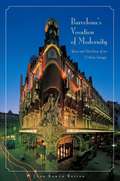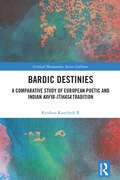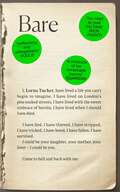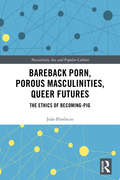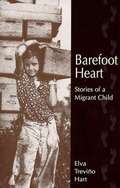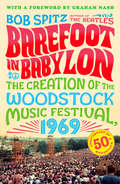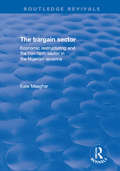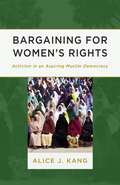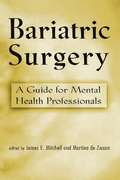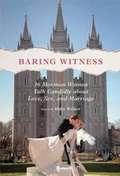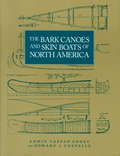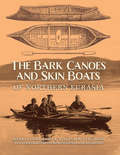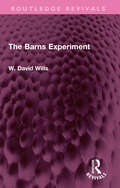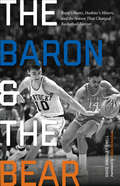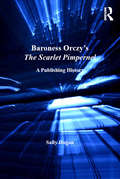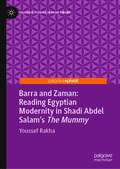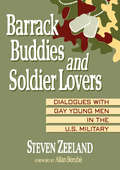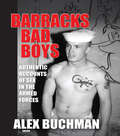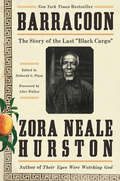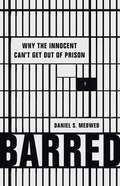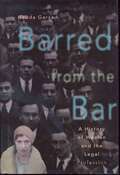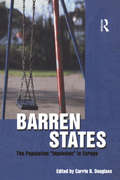- Table View
- List View
Barcelona's Vocation of Modernity
by Joan Ramon ResinaSince the closing decades of the nineteenth century, Barcelona has striven to sustain an image of modernity that distinguishes itself within Spain. Barcelona's Vocation of Modernity traces the development of that image through texts that foreground key social and historical issues. It begins with Barcelona's "coming of age" in the 1888 Universal Exposition and focuses on the first major narrative work of modern Catalan literature, La febre d'or. Positing an inextricable link between literature and modernity, Resina establishes a literary framework for the evolution of the image of Barcelona's modernity through the 1980s, when the consciousness of modernity took on an ironic circularity. Because the city is an aggregation of knowledge, Resina draws from sociology, urban studies, sociolinguistics, history, psychoanalysis, and literary history to produce a complex account of Barcelona's self-reflection through culture. The last chapter offers a glimpse into the "post-historical" city, where temporality has been sacrificed to the spatialization associated with the seductions of the spectacle.
Bardic Destinies: A Comparative Study of European Poetic and Indian Kavya-Itihasa Tradition (Critical Humanities Across Cultures)
by Krishna R. KanchithThis volume critically explores the cultural significance and fate of the “literary” in the European and the Indian traditions as it traces the history of the reception of works that have had a deep hold on the lives and sensibilities of people across time and cultures. The book grapples with three major concepts in the humanities—the literary, the philosophical/theological and the historical. It looks at Homer’s reception by Plato; Virgil’s reception by Christianity; the many responses that The Mahabharata has received over centuries and across cultures in India; and the reception of Kumaravyasa’s Kumaravyasabharata, among other works, and analyses the understanding of truth, time and history that influence the reading of these works in different times and cultural contexts. Part of the Critical Humanities across Cultures series, this book will be useful for scholars and researchers of philosophy, literature, history, comparative literature, cultural studies and post-colonial studies.
BARE: 'You have to read this book' MICK JAGGER
by Lorna TuckerThe inspirational true story of one woman's fight to survive on the streets of LondonI, Lorna Tucker, have lived a life that most you can't even begin to imagine...'You need to read this book' MICK JAGGER'Unflinching and unforgettable' VOGUE 'An essential read showcasing the resilience of the human spirit' JUANO DIAZI have lived in London's piss-soaked streets, I have lived with the sweet embrace of heroin, I have lived when I should have died.I have lied, I have thieved, I have stripped, I have tricked, I have loved, I have fallen, I have survived. I could be your daughter, your mother, your lover - I could be you.Come to hell and back with me.AN EYE-OPENING, PERSONAL ACCOUNT OF FEMALE HOMELESSNESS, FROM ONE OF BRITAIN'S MOST EXCITING FILM-MAKERS
BARE: 'You have to read this book' MICK JAGGER
by Lorna TuckerThe inspirational true story of one woman's fight to survive on the streets of LondonI, Lorna Tucker, have lived a life that most you can't even begin to imagine...'You need to read this book' MICK JAGGER'Unflinching and unforgettable' VOGUE 'An essential read showcasing the resilience of the human spirit' JUANO DIAZI have lived in London's piss-soaked streets, I have lived with the sweet embrace of heroin, I have lived when I should have died.I have lied, I have thieved, I have stripped, I have tricked, I have loved, I have fallen, I have survived. I could be your daughter, your mother, your lover - I could be you.Come to hell and back with me.AN EYE-OPENING, PERSONAL ACCOUNT OF FEMALE HOMELESSNESS, FROM ONE OF BRITAIN'S MOST EXCITING FILM-MAKERS
BARE: 'You have to read this book' MICK JAGGER
by Lorna TuckerThe inspirational true story of one woman's fight to survive on the streets of LondonI, Lorna Tucker, have lived a life that most you can't even begin to imagine...'You need to read this book' MICK JAGGER'Unflinching and unforgettable' VOGUE 'An essential read showcasing the resilience of the human spirit' JUANO DIAZI have lived in London's piss-soaked streets, I have lived with the sweet embrace of heroin, I have lived when I should have died.I have lied, I have thieved, I have stripped, I have tricked, I have loved, I have fallen, I have survived. I could be your daughter, your mother, your lover - I could be you.Come to hell and back with me.AN EYE-OPENING, PERSONAL ACCOUNT OF FEMALE HOMELESSNESS, FROM ONE OF BRITAIN'S MOST EXCITING FILM-MAKERS
Bareback Porn, Porous Masculinities, Queer Futures: The Ethics of Becoming-Pig (Masculinity, Sex and Popular Culture)
by João FlorêncioThis book analyses contemporary gay "pig" masculinities, which have emerged alongside antiretroviral therapies, online porn, and new sexualised patterns of recreational drug use, examining how they trouble modern European understandings of the male body, their ethics, and their political underpinnings. This is the first book to reflect on an increasingly visible new form of sexualised gay masculinity, and the first monograph to move debates on condomless sex amongst gay men beyond discourses of HIV and/or AIDS. It contributes to existing critical histories of sexuality, pornography and other sex media at a crucial juncture in the history of gay male sex cultures and the HIV epidemic. The book draws from fieldwork, interviews, archival research, visual analysis, philosophy, queer theory, and cultural studies, using empirical, critical, and speculative methodologies to better think gay "pig" masculinities across their material, affective, ethical and political dimensions, in a future-oriented, politically-inflected, reflection on what queer bodies may become. Spanning historical context to empirical and theoretical study, Bareback Porn, Porous Masculinities, Queer Futures will be of key interest to academics and students in sexuality studies, film, media, visual culture, cultural studies, and porn studies concerned with masculinities, sex and sexualities and their circulation across an array of media.
Barefoot Heart: Stories of a Migrant Child
by Elva Treviño Hart"Barefoot Heart is a vividly told autobiographical account of the life of a child growing up in a family of migrant farm workers. It brings to life the day-to-day existence of people facing the obstacles of working in the fields and raising a family in an environment that is frequently hostile to those who have little education and speak another language. This book is also the story of how the author overcame the disadvantages of this background, discovered her true talents, and, in the process, found herself." --BOOK JACKET. Title Summary field provided by Blackwell North America, Inc.
Barefoot in Babylon: The Creation of the Woodstock Music Festival, 1969
by Bob Spitz"Mr. Spitz feeds us every riveting detail of the chaos that underscored the festival. It makes for some out-a-sight reading, man." The New York Times Book Review Celebrating its 45th anniversary in 2014, the Woodstock Music Festival defined a generation. Yet, there was much more than peace and love driving that long weekend the summer of 1969. In Barefoot in Babylon, journalist and New York Times bestselling author Bob Spitz gives readers a behind-the-scenes look at the making of Woodstock, from its inception and the incredible musicians that performed to its scandals and the darker side of the peace movement. With a new introduction, as well as maps, set lists, and a breakdown of all the personalities involved, Barefoot in Babylon is a must-read for anyone who was there--or wishes they were.
The Bargain Sector (Routledge Revivals)
by Kate MeagherThis title was first published in 2001: Does the non-farm sector offer new hope for rural Africa? In the face of economic crisis and restructuring across Africa, small-scale enterprise has come to play a central role in rural livelihood and accumulation strategies. This apparent dynamism has attracted favourable attention from development thinkers and policy-makers, who have identified non-farm enterprise as a new low-cost agent of rural development. The research in this book challenges the growing consensus on the developmental potential of the non-farm sector. On the basis of recent fieldwork, the author argues that the prospects for non-farm led growth have been seriously undermined by the crippling pressures of structural adjustment, agricultural instability and rural as well as interregional inequality. Detailed village case-studies from the populous and highly commercialized grain surplus region of the Nigerian savanna leads the reader to investigate the link between local economic and social realities, and the wider regional, national and global processes that form the development of the non-farm sector in Africa. Far from offering a bargain solution, the author demonstrates that significant investment in agriculture and entrepreneurial development will be needed to create an enabling environment for non-farm growth.
Bargaining for Women's Rights: Activism in an Aspiring Muslim Democracy
by Alice J. KangGender relations in Muslim-majority countries have been subject to intense debate in recent decades. In some cases, Muslim women have fought for and won new rights to political participation, reproductive health, and education. In others, their agendas have been stymied. Yet missing from this discussion, until now, has been a systematic examination of how civil society groups mobilize to promote women&’s rights and how multiple components of the state negotiate such legislation.In Bargaining for Women&’s Rights, Alice J. Kang argues that reform is more likely to happen when the struggle arises from within. Focusing on how a law on gender quotas and a United Nations treaty on ending discrimination against women passed in Niger while family law reform and an African Union protocol on women&’s rights did not, Kang shows how local women&’s associations are uniquely positioned to translate global concepts of democracy and human rights into concrete policy proposals. And yet, drawing on numerous interviews with women&’s rights activists as well as Islamists and politicians, she reveals that the former are not the only ones who care about the regulation of gender relations.Providing a solid analytic framework for understanding conflict over women&’s rights policies without stereotyping Muslims, Bargaining for Women&’s Rights demonstrates that, contrary to conventional wisdom, Islam does not have a uniformly negative effect on the prospects of such legislation.
Bariatric Surgery: A Guide for Mental Health Professionals
by James E. Mitchell Martina De ZwaanThis book provides mental health professionals with a basic overview of the types of procedures involved in bariatric surgery and the specific psychological impacts such operations can have on their patients. It also serves as a valuable resource to surgeons, nurses, doctors, and support staff who are involved in the medical treatment of obesity, but who may have little background in the psychosocial implications of their work. An accompanying questionnaire is available at http://www.eatingdisordersarena.com/resources/EDQ.pdf
Baring Witness: 36 Mormon Women Talk Candidly about Love, Sex, and Marriage
by Holly WelkerIn Baring Witness , Welker and thirty-six Mormon women write about devotion and love and luck, about the wonder of discovery, and about the journeys, both thorny and magical, to humor, grace, and contentment. They speak to a diversity of life experiences: what happens when one partner rejects Church teachings; marrying outside one's faith; the pain of divorce and widowhood; the horrors of spousal abuse; the hard journey from visions of an idealized marriage to the everyday truth; sexuality within Mormon marriage; how the pressure to find a husband shapes young women's actions and sense of self; and the ways Mormon belief and culture can influence second marriages and same-sex unions. The result is an unflinching look at the earthly realities of an institution central to Mormon life.
The Bark Canoes and Skin Boats of North America
by Edwin Tappan Adney Howard I. ChappelleThe bark canoes of the North American Indians, particularly those of birchbark, were among the most highly developed manually propelled primitive watercraft. They could be used to carry heavy loads in shallow streams but were light enough to be hauled long distances over land. Built with Stone Age tools from available materials, their design, size, and appearance were varied to suit the many requirements of their users. Upon arrival in North America, European settlers began using the native-made craft for traveling through the wilderness. Even today, canoes are based on these ancient designs. This fascinating guide combines historical background with instructions for constructing one. Author Edwin Tappan Adney, born in 1868, devoted his life to studying canoes and was practically the sole scholar in his field. His papers and research have been assembled by a curator at the Smithsonian Institution, and illustrated with black-and-white line drawings, diagrams, and photos.Included here are measurements, detailed drawings, construction methods, and models. The book covers canoes from Newfoundland to the Pacific Ocean, as well as umiaks and kayaks from the Arctic.
The Bark Canoes and Skin Boats of Northern Eurasia
by Harri Luukkanen William W. FitzhughThe Bark Canoes and Skin Boats of Northern Eurasia is a history and description of bark and skin boat traditions of the native peoples of Scandinavia and northern Russia. The history of northern peoples and cultures is inextricably linked to the technology of water transport. This is particularly true in northern Eurasia, where lakes and rivers can connect when overland summer travel is restricted by thick forests or bogs. For thousands of years, native peoples used a variety of bark and skin boats for fishing, hunting, trading, making war, and migrating.The Eurasian peoples, responding to their geography, climate, and environment, learned to construct--and perfect--small watercraft made from dug-out logs or the bark of birch, aspen, larch, and other trees, each variety crafted for its special use and environment. The text describes the design, construction, and uses of skin and bark boats for thirty-five traditional cultures ranging from northern Scandinavia to the Russian Far East, from the Bering Strait to northern China, and from South Siberia to the Arctic Ocean. Regional chapters use evidence from archaeology, historical illustrations and maps, and extensive documentation from ethnography and historical literature to reveal how differences in cultural traditions, historical relationships, climate, and geography have influenced the development and spread of watercraft before the introduction of modern planked boats.This definitive volume is richly illustrated with historical photographs and drawings, first-person explorer accounts from the 16th-19th centuries, and information on traditional bark and skin preparation, wood-bending, and other construction techniques. The Bark Canoes and Skin Boats of Northern Eurasia presents a first-ever overview of northern Eurasian boating traditions and serves as the companion to Charles Adney's and Howard Chapelle's classic, The Bark Canoes and Skin Boats of North America (1964).
The Barns Experiment (Routledge Revivals)
by W. David WillsOriginally published in 1945, this is a concise account of the remarkable experiment with boys carried out by the author of The Hawkspur Experiment. The war put this latter experiment into abeyance, but gave its author an opportunity to practice his principles on a group of younger difficult boys. Aged from eight to fourteen, these boys were the "throw-outs" of the Evacuation Scheme, but before the Barns experiment had been long in operation troublesome boys were being evacuated not primarily to escape bombs, but in order that they might have the treatment that Barns provided. Barns was a Hostel-school initiated by the Society of Friends, where lawless boys made their own laws, and where the principle instrument in their reformation was not punishment but affection. So successful were the unconventional methods here described that sceptics were convinced, and Barns has now achieved a permanent place in the field of "the therapy of the dis-social." Today it would be described as a therapeutic community and is one of the earliest experiments of its kind that raised awareness and paved the way for further research in this area.
The Baron and the Bear: Rupp's Runts, Haskins's Miners, and the Season That Changed Basketball Forever
by David Kingsley Snell Nolan RichardsonIn the 1966 NCAA basketball championship game, an all-white University of Kentucky team was beaten by a team from Texas Western College (now UTEP) that fielded only black players. The game, played in the middle of the racially turbulent 1960s—part David and Goliath in short pants, part emancipation proclamation of college basketball—helped destroy stereotypes about black athletes. Filled with revealing anecdotes, The Baron and the Bear is the story of two intensely passionate coaches and the teams they led through the ups and downs of a college basketball season. In the twilight of his legendary career, Kentucky’s Adolph Rupp (“The Baron of the Bluegrass”) was seeking his fifth NCAA championship. Texas Western’s Don Haskins (“The Bear” to his players) had been coaching at a small West Texas high school just five years before the championship. After this history-making game, conventional wisdom that black players lacked the discipline to win without a white player to lead began to dissolve. Northern schools began to abandon unwritten quotas limiting the number of blacks on the court at one time. Southern schools, where athletics had always been a whites-only activity, began a gradual move toward integration. David Kingsley Snell brings the season to life, offering fresh insights on the teams, the coaches, and the impact of the game on race relations in America.
Baroness Orczy's The Scarlet Pimpernel: A Publishing History (Ashgate Studies In Publishing History: Manuscript, Print, Digital Ser.)
by Sally DuganSince its publication in 1905, The Scarlet Pimpernel has experienced global success, not only as a novel but in theatrical and film adaptations. Sally Dugan charts the history of Baroness Orczy's elusive hero, from the novel's origins through its continuing afterlife, including postmodern appropriations of the myth. Drawing on archival research in Britain, the United States and Australia, her study shows for the first time how Orczy's nationalistic superhero was originally conceived as an anarchist Pole plotting against Tsarist Russia, rather than a counter-revolutionary Englishman. Dugan explores the unique blend of anarchy, myth and magic that emerged from the story's astonishing and complex beginnings and analyses the enduring elements of the legend. To his creator, the Pimpernel was not simply a swashbuckling hero but an English gentleman spreading English values among benighted savages. Dugan investigates the mystery of why this imperialist crusader has not only survived the decline of the meta-narratives surrounding his birth, but also continues to enthrall a multinational audience. Offering readers insights into the Pimpernel's appearances in print, in film and on the stage, Dugan provides a nuanced picture of the trope of the Scarlet Pimpernel and an explanation of the phenomenon's durability.
Barra and Zaman: Reading Egyptian Modernity in Shadi Abdel Salam’s The Mummy (Palgrave Studies in Arab Cinema)
by Youssef RakhaBrilliantly introduced by Nezar Andary, this book is a work of creative nonfiction that approaches writing on film in a fresh and provocative way. It draws on academic, literary, and personal material to start a dialogue with the Egyptian filmmaker Shadi Abdel Salam’s The Mummy (1969), tracing the many meanings of Egypt’s postcolonial modernity and touching on Arab, Muslim, and ancient Egyptian identities through watching the film.
Barrack Buddies and Soldier Lovers: Dialogues With Gay Young Men in the U.S. Military
by Steven ZeelandAmong all the literature published on gays in the military, Steven Zeeland’s first book remains one of a kind. Barrack Buddies and Soldier Lovers is a raw, unsanitized personal record of conversations the author had with young soldiers and airmen stationed in Frankfurt, Germany. Zeeland’s intimate involvement with these men enabled him to document in honest, visceral terms the day-to-day reality of gay military men’s lives and how they work, play, and, in many instances, how the military actually helped them come out. Ironically, despite the military’s antigay policies, these men found that military service placed them in environments where they had to come to terms with their erotic feelings for other men, and sent them overseas to places where they found greater freedom to explore their sexuality than they could have back home. While a few of Zeeland’s buddies were targeted for discharge, most portray an atmosphere of sexually tense tolerance and reveal a surprising degree of openness with straight co-workers and roommates.The 16 fascinating interviews in Barrack Buddies and Soldier Lovers challenge popular assumptions and stereotypes about gay men in the military and provide significant information on: gay military sexual networks male sexual fluidity in barracks life strategies for survival as a gay or bisexual male in the U.S. military German-American relations attitudes toward the gay banThe casual, conversational structure of Barrack Buddies and Soldier Lovers makes it a richly entertaining read. No other book provides such a warm and intimate portrait of the lives of young gay soldiers and airmen.Visit Steven Zeeland at his home page: http://www.stevenzeeland.com
Barracks Bad Boys: Authentic Accounts of Sex in the Armed Forces
by Alex BuchmanUnmistakably original, utterly heartfelt, stranger than fiction, hotter than any off-the-rack gay fantasy! Building on the success of his extraordinary debut-the critically acclaimed, #1 "men&’s interest" bestseller A Night in the Barracks-former U.S. Marine Alex Buchman presents a spellbinding, startlingly unique collection of erotic memoirs by or about "bad boys" in the Armed Forces. Buchman&’s radical approach to an otherwise rigidly formulaic sub-genre: he does the legion of purportedly "true confessions" books with a military theme one better: the first-person narratives he has assembled actually are true. Boldly defying the conventions of gay male "one-handed reading," the unembellished chronicles Buchman brings us from the intensely homoerotic secret world of men in uniform are more erotically charged than any porn-by-numbers fantasy. The theme of Barracks Bad Boys is trouble. All-too-true stories of criminally sexy soldiers and sailors in trouble, who cause trouble, or who just plain are trouble. The unvarnished accounts of romance with baby-faced deserters bound for the brig make for riveting reading. Equally gripping is the disarmingly candid pillow talk of young military men whose trouble runs deeper than mere "unauthorized absence" or "indecent acts." Some of the surprises you&’ll encounter in Barracks Bad Boys include: a straight, married soldier&’s detailed description of his one and only sexual experience with another man a seasoned military chaser&’s review of his all-time favorite sailor-hustlers a dazed gay studies author&’s "I should have known better" journal documenting how young sailors half his age seduced him, gave him street drugs, and pressured him to videotape them performing lewd acts Editor Buchman&’s own offbeat and powerful story of being taken by surprise by the sexual advance of a Marine sergeant who began rubbing Buchman&’s chest and asking him if he felt an "urge to be evil . . ." By turns hair-raising and wrenching, poignant and laugh-out-loud funny, these authentic accounts of sex in the Armed Forces are sure to elicit one universal reaction: no one could make this up! Barracks Bad Boys is compulsory reading for anyone interested in men in uniform; human sexuality in the military; and cutting-edge nonfiction literary erotica.
Barracoon: The Story of the Last "Black Cargo"
by Alice Walker Zora Neale Hurston Deborah G. Plant<P>A major literary event: a newly published work from the author of the American classic Their Eyes Were Watching God, with a foreword from Pulitzer Prize-winning author Alice Walker, brilliantly illuminates the horror and injustices of slavery as it tells the true story of one of the last-known survivors of the Atlantic slave trade—abducted from Africa on the last "Black Cargo" ship to arrive in the United States. <P>In 1927, Zora Neale Hurston went to Plateau, Alabama, just outside Mobile, to interview eighty-six-year-old Cudjo Lewis. <P>Of the millions of men, women, and children transported from Africa to America as slaves, Cudjo was then the only person alive to tell the story of this integral part of the nation’s history. <P>Hurston was there to record Cudjo’s firsthand account of the raid that led to his capture and bondage fifty years after the Atlantic slave trade was outlawed in the United States. <P>In 1931, Hurston returned to Plateau, the African-centric community three miles from Mobile founded by Cudjo and other former slaves from his ship. <P>Spending more than three months there, she talked in depth with Cudjo about the details of his life. <P>During those weeks, the young writer and the elderly formerly enslaved man ate peaches and watermelon that grew in the backyard and talked about Cudjo’s past—memories from his childhood in Africa, the horrors of being captured and held in a barracoon for selection by American slavers, the harrowing experience of the Middle Passage packed with more than 100 other souls aboard the Clotilda, and the years he spent in slavery until the end of the Civil War. <P>Based on those interviews, featuring Cudjo’s unique vernacular, and written from Hurston’s perspective with the compassion and singular style that have made her one of the preeminent American authors of the twentieth-century, Barracoon masterfully illustrates the tragedy of slavery and of one life forever defined by it. Offering insight into the pernicious legacy that continues to haunt us all, black and white, this poignant and powerful work is an invaluable contribution to our shared history and culture. <P><b>A New York Times Bestseller</b>
Barred: Why the Innocent Can't Get Out of Prison
by Daniel S. MedwedA groundbreaking exposé of how our legal system makes it nearly impossible to overturn wrongful convictions Thousands of innocent people are behind bars in the United States. But proving their innocence and winning their release is nearly impossible. In Barred, legal scholar Daniel S. Medwed argues that our justice system&’s stringent procedural rules are largely to blame for the ongoing punishment of the innocent. Those rules guarantee criminal defendants just one opportunity to appeal their convictions directly to a higher court. Afterward, the wrongfully convicted can pursue only a few narrow remedies. Even when there is strong evidence of a miscarriage of justice, rigid guidelines, bias, and deference toward lower courts all too often prevent exoneration. Offering clear explanations of legal procedures alongside heart-wrenching stories of their devastating impact, Barred exposes how the system is stacked against the innocent and makes a powerful call for change.
Barred from the Bar: A History of Women and the Legal Profession (Women Then - Women Now)
by Hedda GarzaThis is an account of women's attempts to become practicing lawyers, gain entrance to law schools, and to obtain the same legal rights as men, such as the right to hold property, etc. This book begins with the American Revolutionary war when women had few legal rights at all and extends to the appointment of the first women to the Supreme Court bench.
Barren States: The Population Implosion in Europe
by Carrie B. DouglassThe fertility rate has dramatically declined across Europe in recent years. Globally, over sixty-four countries have fallen below generation replacement levels and countries in eastern and southern Europe are registering the lowest birth rates in the history of humanity. Demographers emphasize that these developments could have serious repercussions for society and public policy - from a projected drastic loss of national population numbers to labor shortages and a swelling population of over-65s. Typically, analysts have approached the issue of low fertility quantitatively and from state levels. As a result, most research tends to elide any nuanced understanding of this significant trend. Filling a major gap, this timely book goes well beyond existing studies to investigate how people experience, understand and speak about what is called "low fertility." On the individual level, is there such a thing? How do people understand their choices and the perceived limitations on their lives? What is the meaning of motherhood for women today? How has the definition of "family" changed? What are the particularities of fertility decline in each country? And, perhaps most importantly, what does this tendency toward fewer births mean to the women and men who ultimately become demographic statistics? Offering new readings and a much deeper understanding of Europe's decline in fertility, this exciting book adds the voices of everyday people to previous state-centered studies. Overturning a number of assumptions, case studies show that having fewer children is often understood positively in Europe as a means to freedom and self-empowerment. Anyone wishing to understand what low fertility means to the people who live it will find this book essential reading.
Barricades and Borders: Europe 1800-1914, 3rd Edition (Short Oxford History of the Modern World Ser.)
by Robert GildeaThis is a comprehensive survey of European history from the coup d'etat of Napoleon Bonaparte in France to the assassination of the Archduke Ferdinand at Sarajevo, which led to the First World War. It concentrates on the twin themes of revolution and nationalism, which often combined in the early part of the century but which increasingly became rival creeds. Going beyond traditional political and diplomatic history, the book incorporates the results of recent research on population movements, the expansion of markets, the accumulation of capital, social mobility, education, changing patterns of leisure, religious practices, and intellectual and artistic developments. <P><P>The work falls into three chronological sections. The first, starting in 1800 (rather than the more usual 1815) follows the build-up of the revolutionary currents which were eventually going to erupt in the `Year of Revolutions' 1848. The second, from 1850 to 1880, deals with the golden age of capitalism, the successful culmination of struggles for national unification, and the threat of anarchism. The concluding chapters look at the social and political stresses caused by socialism and national minorities, at new attempts by government to order society, imperial rivalry, and the descent into a war which was to mark the end of nineteenth-century Europe. <P><P>For this third edition, Dr Gildea has substantially revised the text and maps, and completely updated the bibliography. New introductory sections guide the reader through the wealth of material in each chapter. The new edition also includes a full chronology of the period, a list of leading state ministers, and family trees for all the major dynasties.
